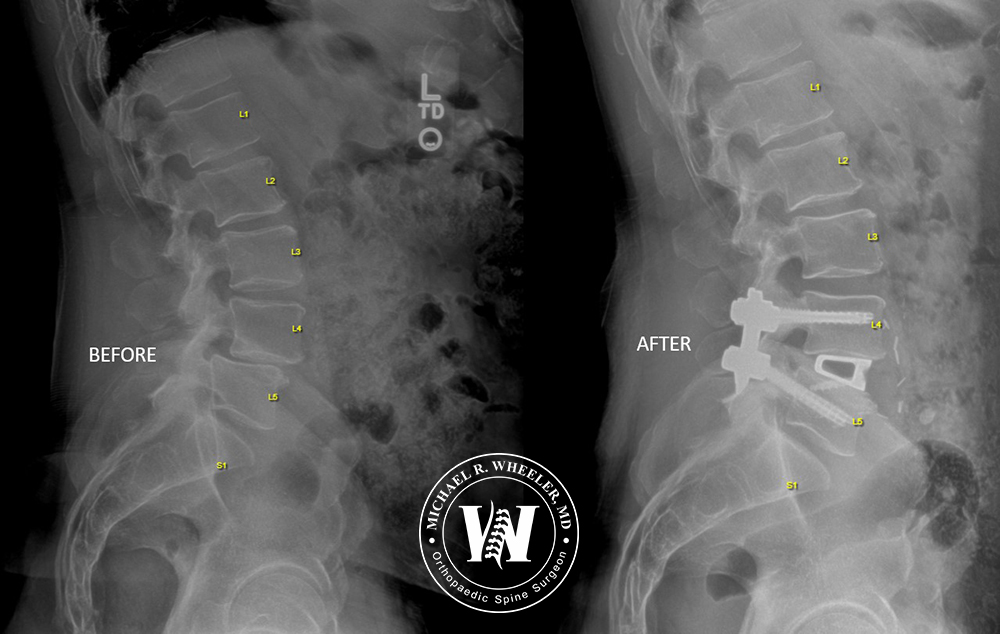Anterior lumbar interbody fusion (ALIF) is a surgical procedure to relieve pain in the lower back and legs. The procedure involves fusing adjacent vertebrae in the lower back. This helps to stabilize the spine and relieves pressure on the nerves.
Traditional spine fusions involve fusing the bones of the back of the spine. During an ALIF, we access the front of the spine, where there is a larger surface area for fusion to occur. This procedure involves removing the disc at the affected level and replacing the disc with a spacer (or cage) that restores adequate height between the vertebrae (bones), takes the pressure off the nerves, and improves spinal alignment.
Benefits of Anterior Lumbar Interbody Fusion (ALIF)
ALIF provides several benefits for patients suffering from lower back pain. The procedure can relieve pressure on the nerves, which can help to reduce pain in the legs and lower back. Some additional benefits include:
- Pain relief
- Improved posture
- Restoration of spinal alignment and lumbar lordosis
- Lower risk of injury to the nerves when compared to fusion surgery performed from the back of the spine
- High rate of successful fusion
Patients who would benefit from Anterior Lumbar Interbody Fusion (ALIF)
ALIF is often recommended for patients who have:
- Degenerative disc disease: This is a condition in which the discs between the vertebrae break down, leading to nerve compression and back pain.
- Spinal stenosis: This is a condition in which the spinal canal narrows, putting pressure on the nerves.
- Flat back: This is a condition in which the lumbar spine lacks appropriate lordosis (curvature)
- Failed back surgery: This occurs when patients have had prior surgery but still experience pain. Often this pain is due to improper spinal alignment, failure of fusion, or problems at the levels above or below the previous surgery.
- Spondylolisthesis: This condition in which one vertebra slips forward over the vertebra below it. It can be caused by aging, injury, or degenerative disc disease.
- Recurrent herniated discs: A herniated disc occurs when the gel-like center ruptures through the outer layer. This can put pressure on the nerves and cause pain.
- Scoliosis: This is a condition in which the spine has abnormal curvature which leads to pain.
Prior to undergoing an ALIF, you should let your surgeon know if you have any of the following:
- History of pelvic radiation
- History of pelvic surgery
- History of spinal infections
- History of aortic aneurysm repair
- History of any abdominal surgery
Before and After Imaging of ALIF Procedure

Procedure
ALIF accesses the spine from the front of the patient. The first portion of the surgery involves getting access to the front of the spine, which is usually performed by a general surgeon. Once the spine is visualized, the ALIF is completed using the following steps:
Step 1: Removal of the disc and cartilage
The disc between the affected levels is carefully removed in its entirety. The cartilage on the top and bottom of the vertebrae is scraped off, preparing the bones for optimal fusion.
Step 2: Trials of different sized spacers
Different sizes of spacers (cages) are placed into the disc space until the correct size is determined. An x-ray machine is used during this portion of the surgery to ensure the best fit of spacer for each individual patient.
Step 3: Placing the cage
Spacers can be made of different materials, but often are a 3D printed titanium cage. Prior to placement in the patient, the cage is filled with bone graft. The cage is then carefully placed in between the vertebrae. X-rays are taken to ensure satisfactory placement of the cage.
Step 4: Incision is closed
The incision on the abdomen is then closed with absorbable suture and a dressing is placed.
During an ALIF, the patient will be given general anesthesia and asleep during the surgery. After the surgery is completed, the patient will be taken to a recovery room, where they will be closely monitored. Most patients stay in the hospital for one to two days after surgery. Sometimes, this surgery is paired with a posterior instrumentation and fusion, which will be discussed separately.
Risks and complications associated with ALIF
In general, the risks associated with ALIF are rare. However, patients should be aware of all risks involved and will discuss the following prior to surgery with the surgeon:
1) Damage to Large Blood Vessels
Anterior lumbar interbody fusion is done near large blood vessels. There is a risk of damage to these vessels, leading to bleeding and blood clots. However, this complication is rare and nationally occurs in about 3% of cases. To minimize any risk or complications, there is always a general or vascular surgeon present to assist in gaining access to the front of the spine during the ALIF. Even if damage to a blood vessel occurs, these usually can be quickly fixed without consequence.
2) Retrograde Ejaculation
Retrograde ejaculation is a rare complication of anterior lumbar interbody fusion. Less than 1% of men who have this surgery experience retrograde ejaculation. It occurs when the surgery damages the nerves that control ejaculation. This can cause semen to be released into the bladder during orgasm instead of through the penis.
3) Damage to Abdominal Organs
The surgical path of anterior lumbar interbody fusion is close to the abdominal organs such as the bladder, kidneys, colon, and ureter. There is a small risk of damage to these organs.
4) Migration of the cage
In rare cases, the cage placed between the bones can move. This can lead to problems with healing and may require revision surgery. With modern technique, the risk of this is nearly eliminated.
References & Resources
- https://www.spine-health.com/treatment/spinal-fusion/potential-risks-and-complications-alif-surgery
- https://mayfieldclinic.com/pe-alif.htm
- https://orthoinfo.aaos.org/en/treatment/anterior-lumbar-interbody-fusion/
- https://www.precisionhealth.com.au/healthcare-services/advanced-neurosurgery-spinal-surgery/procedures-and-surgery/anterior-lumbar-interbody-fusion-alif/
- https://www.spineuniverse.com/treatments/surgery/lumbar/anterior-lumbar-interbody-fusion-alif-surgery-treats-low-back-pain
- https://www.emoryhealthcare.org/orthopedics/anterior-lumbar-interbody-fusion.html
- https://www.armaghanispine.com/pdfs/alif-post-op-instructions.pdf
- https://www.sciencedirect.com/science/article/pii/S1877056819303299



